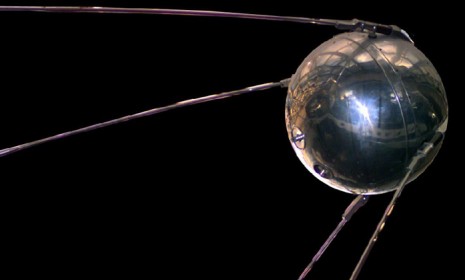Why the U.S. wanted to nuke the moon during the Cold War
In the 1950s, with a young Carl Sagan lending a hand, America considered a novel way to outshine the Soviets


It sounds like the scheme of a James Bond villain — or even Dr. Evil from the Austin Powers movies — but the U.S. was once dead serious about attacking the moon with an atom bomb. The time was the 1950s, and America's arch-enemy the Soviet Union had just humiliated the U.S. with its 1957 launch of the first successful spacecraft, the satellite Sputnik 1. In the panic that followed, the U.S. Air Force approached the physicist Leonard Reiffel in 1958 to come up with plan to make a highly visible mushroom cloud on the moon.
The top-secret project was given the innocuous name "A Study of Lunar Research Flights," or the more X-Files-friendly Project A119. Among Reiffel's hires at the military-funded Armour Research Foundation (now the Illinois Institute of Technology Research Institute) was a young Carl Sagan, then a graduate student, who modeled how the gas-and-dust cloud would expand in low-gravity. Reiffel says the point of blowing a hole in the moon was to put on a show for the Soviets, and recapture some morale from the space-race loss. It would have been technically possible by 1959, when the U.S. launched its first intercontinental ballistic missile, Reiffel told Britain's The Observer in 2000, and the U.S. could have hit its target with an accuracy of about two miles.
"This accuracy would have been particularly important, as the Air Force wanted the resulting explosion to be clearly visible from Earth," says Daven Hiskey at Mental Floss. "As such, it was proposed that the explosion happen on the border of the visible part of the moon, so that the resulting mushroom cloud would be illuminated by the sun." The project obviously (and thankfully) never came to fruition, "as it was felt that the public would not respond favorably to the U.S. dropping a nuclear bomb on the moon." And aside from contaminating the pristine lunar surface, Reiffel notes, the crater could have ruined the visage of the man on the moon. The Air Force was also worried about what would happen on Earth if the project failed.
The Week
Escape your echo chamber. Get the facts behind the news, plus analysis from multiple perspectives.

Sign up for The Week's Free Newsletters
From our morning news briefing to a weekly Good News Newsletter, get the best of The Week delivered directly to your inbox.
From our morning news briefing to a weekly Good News Newsletter, get the best of The Week delivered directly to your inbox.
The Air Force is still refusing to comment publicly on the project, and in fact we may never have known of the plan to nuke the moon if not for Sagan. The famous astrophysicist died in 1996, but biographer Keay Davidson discovered in the 1990s that Sagan had discussed the project when applying for the Miller Institute graduate fellowship at Berkeley in 1959. The project plans were all destroyed in 1987. "It was well known that the existence of this project was top secret," Reiffel told The Observer, and Sagan violated national security. "Had Sagan wanted to make any disclosures to any party, as his boss at the time, I would have had to take forward any such request and Air Force permission would have been extremely unlikely in those very tense times."
Sources: ANI, AP/Daily Mail, Mental Floss, Observer
A free daily email with the biggest news stories of the day – and the best features from TheWeek.com
Peter has worked as a news and culture writer and editor at The Week since the site's launch in 2008. He covers politics, world affairs, religion and cultural currents. His journalism career began as a copy editor at a financial newswire and has included editorial positions at The New York Times Magazine, Facts on File, and Oregon State University.
-
 Biggest political break-ups and make-ups of 2025
Biggest political break-ups and make-ups of 2025The Explainer From Trump and Musk to the UK and the EU, Christmas wouldn’t be Christmas without a round-up of the year’s relationship drama
-
 Why 2025 was a pivotal year for AI
Why 2025 was a pivotal year for AITalking Point The ‘hype’ and ‘hopes’ around artificial intelligence are ‘like nothing the world has seen before’
-
 The best drama TV series of 2025
The best drama TV series of 2025the week recommends From the horrors of death to the hive-mind apocalypse, TV is far from out of great ideas
